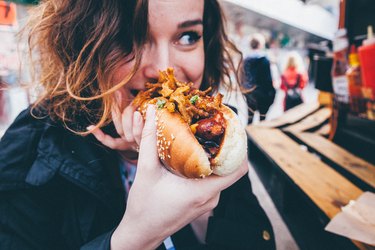4 Foods to Avoid if You Want to Lose Belly Fat — and What to Eat Instead

Katarína Mittáková / EyeEm/EyeEm/GettyImages
When it comes to belly fat, there’s not one specific thing that packs the pounds around your midsection. Fat accumulates at your waistline thanks to a combination of factors, including genetics, stress and sleep habits, but what you eat also plays a major role.
Indeed, too much visceral fat — marked by a waist circumference of 35 to 40 inches in most adults— has been linked to an increased risk for such conditions as heart disease, diabetes and high blood pressure, per Harvard Health Publishing.
The good news is that visceral fat is the first to go when you clean up your diet and start to lose weight. Beyond cutting calories, though, the quality of the food you’re eating seems to play a key part in how much visceral fat your body tucks away.
Here’s what the research says about which foods may lead to belly fat, and which might just help to blast it away.
1. Processed Meat
Bacon, sausage and deli meats have rarely been associated with a healthy diet. When it comes to reducing visceral fat and your waistline, though, it may be even more important to cut down on these foods.
A large August 2011 study in PLOS One involving 50,000 people found that eating processed meat was associated with a greater BMI and waist circumference.
2. Sugar-Sweetened Beverages
Soft drinks and energy drinks are usually packed full of empty calories with little nutritional value. What’s more, a February 2014 study in The American Journal of Clinical Nutrition found that visceral fat tends to increase along with increased soda drinking, so reducing your intake of these beverages is a no-brainer.
There may be a special case for making coffee your sub of choice: A May 2020 study in The Journal of Nutrition found that people who drink two or three cups of java daily (caffeinated or decaf) have lower total body and abdominal fat than those who drink less. It’s worth noting that the link was stronger in people assigned female at birth (AFAB) vs assigned male at birth (AMAB).
According to the Mayo Clinic, drinking excess alcohol can lead to a “beer belly,” but the alcohol itself isn’t solely to blame. Drinking too much alcohol of any variety adds extra calories, and those extra calories can contribute to a wider girth.
If you’re concerned with the size of your waist, make sure to drink alcohol in moderation, which means one to two drinks per day, according to the Centers for Disease Control and Prevention.
Fast food is a convenient option when you’re on-the-go, but too much may wreck havoc on your midsection. According to the Harvard T.H. Chan School of Public Health, people who eat more fast food also weigh more, have higher triglycerides and have a larger waist circumference than those who eat less.
Fast food is usually high in saturated fat and salt and low in overall nutrients, like vitamins, minerals and fiber. And while you don’t have to swear off fries for life, try to limit fast food to those times when you’re in a pinch for a meal or have a specific craving in order to help minimize belly fat.
Sure, there are foods to avoid for a slimmer middle — but what about foods that burn belly fat? There’s actually no such thing (so don’t fall for those “belly fat burner” gimmicks) — but eating foods rich in fiber is linked to less belly fat.
Good sources of fiber include:
- Fruits and vegetables
- Beans and legumes
- Nuts and seeds
- Oats
- Whole-grain or whole-wheat pasta
- Whole-grain bread
- Quinoa
There are a lot of other benefits to eating a high-fiber diet, per the Mayo Clinic, including lower cholesterol levels, better blood sugar control, healthy weight maintenance and better bowel health. Eating more fiber has even been linked to living longer.
Unfortunately, only about 5 percent of Americans are getting the recommended amount of the nutrient, according to a paper in the January-February 2017 issue of the American Journal of Lifestyle Medicine, which is anywhere from 25 to 38 grams per day, per the Dietary Guidelines for Americans.
The Mayo Clinic offers the following tips for increasing your fiber intake:
- Eat a high-fiber breakfast cereal.
- Switch grain products for whole grains and aim for at least 2 grams of fiber per serving.
- Bulk up baked goods by substituting white flour for a whole-grain option.
- Increase fruit and vegetables to meet at least five servings or more per day.
- Include legumes (think: beans, peas, lentils) whenever possible.
- When snacking, choose fresh fruits and vegetables, nuts and seeds and whole-grain options.



